March 2010 Archives
 Utropspris: $10,000-15,000. Mer hos MONDOBLOGO.
Utropspris: $10,000-15,000. Mer hos MONDOBLOGO.Finding a corduroy-clad ultra-geek manbrarian that pairs Jarvis Cocker's sartorial style with Louis Theroux's haplessness has been my life's work.Kanske kommer Gustaf Skarsgårds rollgestaltning av "KB-mannen" i den kommande TV-serien vara den perfekta kombinationen av stil och svårmod. Mina vaga minnen av verklighetens boktjuv stämmer inte riktigt överens med valet av skådespelare.
 Japanska arkitektduon Kazuyo Sejima och Ryue Nishizawa, som leder SANAA, har vunnit årets Pritzker-pris. Jag skrev om deras Rolex Learning Centre häromsistens. Se bildspelet hos NPR för några av deras andra verk.
Japanska arkitektduon Kazuyo Sejima och Ryue Nishizawa, som leder SANAA, har vunnit årets Pritzker-pris. Jag skrev om deras Rolex Learning Centre häromsistens. Se bildspelet hos NPR för några av deras andra verk.  commonsExplorer är ett fint litet (Java-)program för att utforska samlingarna i The Flickr Commons, bl.a. från svenska Riksantikvarieämbetet.
commonsExplorer är ett fint litet (Java-)program för att utforska samlingarna i The Flickr Commons, bl.a. från svenska Riksantikvarieämbetet.The application grabs titles and thumbnails for the whole selected collection - hundreds or thousands of images. Words in image titles are visualised in the text cloud: larger words occur in many titles. Hovering over a word highlights images with titles containing that word, and shows which other words occur in those images.Skapat vid Faculty of Arts & Design, University of Canberra. (via: Mitchell Whitelaw).

Särskilt med tanke på att det var två fantastiska bibliotekarier rätt långt från Stureplan som startade hela modebloggskategorin i Sverige. Och sedan "försvann" när de inte kände för att blogga längre.Tyvärr så är Annas och Malins blogg inte längre tillgänglig på mymarkup.net/anna (inte heller min gamla på mymarkup.net), mest för att jag inte hunnit/orkat/kunnat flytta alltihopa till en ny plats på internets. Men det ska bli av! Ber om ursäkt för att jag orsakat ett minnehåll tills det är åtgärdat.
Packaging is important. We judge books by their covers and even by how much they weigh (heavy books make poor subway/bus reading). Format matters. (...) Newspaper and magazine reviewers pretty much ignore this stuff. (...) That citizen reviewers have keyed into this more quickly than traditional media reviewers is not a surprise.Och i en underbar konstkritisk undersökning (förvisso publicerad i International Journal of Obesity) har forskare studerat tusen år av "Sista måltiden"-versioner och kommit fram till att den genomsnittliga måltiden har ökat med 66 %, medan det tillhörande brödet ökat med 22 %. The Guardian skriver (liksom DN):
Computer-aided design technology enabled the researchers to scan and rotate items in the paintings, allowing head, plate, meal and bread size to be calculated.Också konstkritiken har fokuserat på fel saker.
Det ska tilläggas att forskaren Brian Wansink vann ett Ig Nobel-pris 2007, för en designen av en soppskål som aldrig blir tom.
 Det är sånt här man skulle kunna göra med Newspaper Club: As It Is Today -
Det är sånt här man skulle kunna göra med Newspaper Club: As It Is Today - A 12 page newsprint periodical collecting and collating the best of literature from travel guides, treatises, pamphlets, books, receipts and ephemera. Each looks through the lens "of to-day", revelling in the present and present history, whether from the 18th Century or the 20th.(via: Chris Heathcote)
Ett låååååångt citat från Ian McEwans Solar, om hur man känner sig ibland (illustrerat ovan av en synnerligen humorlös Nobelpristagare (Horace would approve)):
And none of these young men appeared as much in awe of Michael Beard, Nobel laureate, as he thought they should. Clearly, they knew of his work, but in meetings they referred to it in passing, parenthetically, in a dismissive mumble, as though it had long been superseded, when in fact the opposite was true, the Beard-Einstein Conflation was in all the textbooks, unassailable, experimentally robust. As undergraduates the ponytails would surely have witnessed a demonstration of the 'Feynman Plaid', illustrating the topographical essence of Beard's work. But at informal gatherings in the canteen these giant children become frontiersmen of theoretical physics and spoke round the Conflation, treated it as one might a dusty formulation by Sir Humphry Davy, and made elliptical references to BLG or some overwrought arcana in M-theory or Nambu Lie 3-algebra as if it were not a change of subject. And that was the problem. Much of the time he did not know what they were saying. The ponytails spoke at speed, on a constant, rising interrogative note, which caused an obsure muscle to tighten in the back of Beard's through as he listened. They failed to enunciate their words, going only so far with a thought, until one of the others muttered, 'Right!', after which they would jump to the next unit of utterance - one could hardly call it a sentence.
But it was far worse than that. Some of the physics which they took for granted was unfamiliar to him. When he looked it up at home, he was irritated by the length and complexity of the calculations. He liked to think he was an old hand and knew his way around string theory and its major variants. But these days there were simply too many add-ons and modifications. When Beard was a twelve-year-old schoolboy, his maths teacher had told the class that whenever they found an exam question coming out at eleven nineteenths or thirtheen twenty-sevents, they should know they had the wrong answer. Too messy to be true. Frowning for two hours at a stretch, so that the following morning parallell pink lines were still visible across his foreheard, he read up on the latest, on Bagger, Lambert and Gustavsson - of course! BLG was not a sandwich - and their Lagrangian description of coincident M2-branes. God may or may not have played dice, but surely He was nowhere near this clever, or such a show-off. The material world simply could not be so complicated.
Alexandriabiblioteket leddes under de första 150 åren av förnämliga personlig- heter. Den mest berömde var Kallimakos vid mitten av 200-talet fKr, för övrigt sin tids främste diktare. Han grundade litteraturvetenskapen. En av hans efterföljare misstänktes för att vilja flytta till biblioteket i Pergamon. Han sattes i husarrest av den dåvarande kungen som inte ville förlora honom - den högsta uppskattning, har det sagts, som kommit någon bibliotekarie till del från en anslagsgivande myndighet!Snubben i fråga är Aristofanes från Bysans. Innan honom var Eratosthenes chef på bibblan i Alexandria. Han var känd bland kollegor som "beta", eftersom han var näst bäst på allt i nästan alla ämnen.
Hell yeah!With the advent of the 21st century, increasing amounts of data from the domain of qualitative humanities and social science research have become available for quantitative analysis. Private enterprises (Google Books and Earth, Youtube, Flickr, Twitter, Freebase, IMDb, among others) as well as public and non-profit institutions (Europeana, Wikipedia, DBPedia, Project Gutenberg, WordNet, Perseus, etc) are in the process of collecting, digitizing, and structuring vast amounts of information, and creating technologies, applications, and services (Linked Open Data, Open Calais, Amazon's Mechanical Turk, ReCaptcha, ManyEyes, etc), which are transforming the way we do research.
Utilizing a complex systems approach to harness these data, the contributors of this event aim to make headway into the territory of traditional humanities and social sciences, understanding history, arts, literature, and society on a global-, meso- and granular level, using computational methods to go beyond the limitations of the traditional researcher.
 Unqualified Reservations i ett långt inlägg om vad kommer att ersätta Google - den feodala sökmotorn Feudle:
Unqualified Reservations i ett långt inlägg om vad kommer att ersätta Google - den feodala sökmotorn Feudle: Feudal search (Feudle, perhaps) is feudal because, rather than computing a single democratic algorithm on the global, unstructured Web, it follows the natural hierarchical structure of all human institutions. Rather than passively computing rank from the random patterns of interaction in an atomized society, provide the institutions necessary for that society to recompose itself in an organized, aristocratic hierarchy. And stand back - the result will work a lot better.
Den här har snurrat runt på nätet, men videon till Hot Chips "I Feel Better" är värd att titta på ända till slutet.
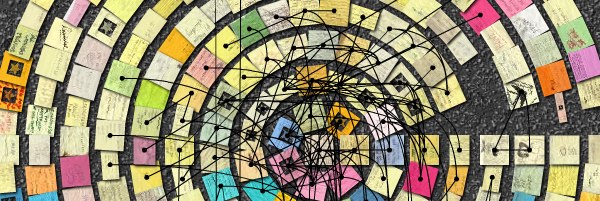 AnthroPosts samlar upphittade Post It-lappar och gör dom meningsfulla för dig och mig. Skapat av Noah Pedrini.
AnthroPosts samlar upphittade Post It-lappar och gör dom meningsfulla för dig och mig. Skapat av Noah Pedrini.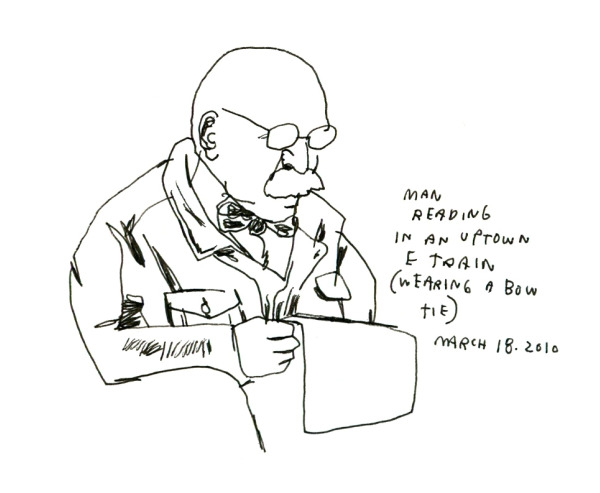
Jason Polans målsättning är ambitiös, men jag tror han kommer att lyckas: en teckning av varje människa i New York.
 Värmland of Scandinavia är bara en väldigt fint utförd turistsajt.
Värmland of Scandinavia är bara en väldigt fint utförd turistsajt.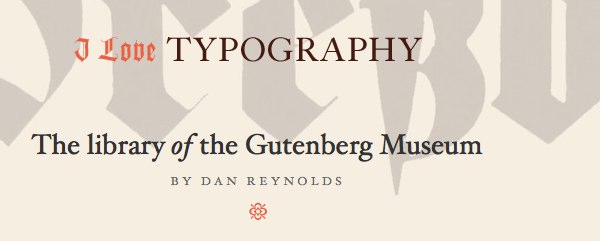 I Love Typography har besökt biblioteket på Gutenberg-museet i Mainz, och skriver om typografiska provkartor.
I Love Typography har besökt biblioteket på Gutenberg-museet i Mainz, och skriver om typografiska provkartor. Äntligen har man kommit fram till det internationella typografiska tecknet för ironi/sarkasm: SarcMark. Jättebra
Äntligen har man kommit fram till det internationella typografiska tecknet för ironi/sarkasm: SarcMark. Jättebra .
. Flame är ett awesome ritverktyg (skapat med processing). Jag är säker på att du kan överträffa mitt verk ovan.
Flame är ett awesome ritverktyg (skapat med processing). Jag är säker på att du kan överträffa mitt verk ovan.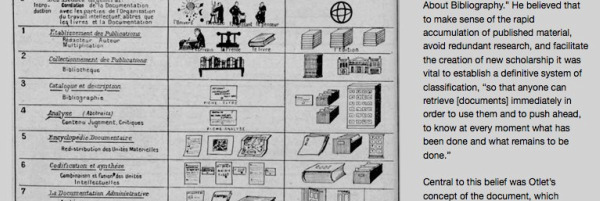 Det 8:e numret av nätmagasinet Triple Canopy innehåller en massa fint, men jag fäster mig särskilt vid Molly Springfields "artikel" om den belgiske informationsvetaren Paul Otlet - "Inside the Mundaneum". Jag menar, vem blir inte nyfiken av den här inledningen?
Det 8:e numret av nätmagasinet Triple Canopy innehåller en massa fint, men jag fäster mig särskilt vid Molly Springfields "artikel" om den belgiske informationsvetaren Paul Otlet - "Inside the Mundaneum". Jag menar, vem blir inte nyfiken av den här inledningen?ON THE NIGHT OF JUNE 1, 1934, a Belgian information scientist named Paul Otlet sat in silent, peaceful protest outside the locked doors of a government building in Brussels from which he had just been evicted. Inside was his life's work: a vast archive of more than twelve million bibliographic three-by-five-inch index cards, which attempted to catalog and cross-reference the relationships among all the world's published information. For Otlet, the archive was at the center of a plan to universalize human knowledge. He called it the Mundaneum, and he believed it would usher in a new era of peace and progress. The Belgian government, however, had come to view Otlet and his fine mess of papers, dusty boxes, and customized filing cabinets as a financial and political nuisance.Det finns en film om Otlet (från 1998) också, liksom en bra artikel av Alex Wright - "Forgotten Forefather: Paul Otlet" från 2003.
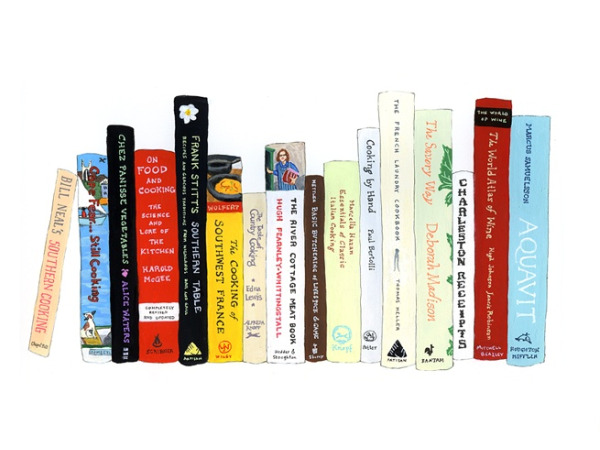 Jane Mount målar porträtt av folks bokhyllor, eller "idealiska" såna är nog mer korrekt.
Jane Mount målar porträtt av folks bokhyllor, eller "idealiska" såna är nog mer korrekt. Se också: Fjärilar i omloppsbana.
 Myrmannen, m.m., E.O. Wilson, har skrivit sin första roman, Anthill, en slags myrornas Iliaden, som New York Review of Books recenserar:
Myrmannen, m.m., E.O. Wilson, har skrivit sin första roman, Anthill, en slags myrornas Iliaden, som New York Review of Books recenserar:What to make of Anthill ? Part epic-inspired adventure story, part philosophy-of-life, part many-layered mid-century Alabama viewed in finely observed detail, part ant life up close, part lyrical hymn to the wonders of earth, part contribution to the growing genre of eco-lit: yes, all these. But hidden within Anthill is also a sort of instruction manual. Here's an effective way of saving the planet, one anthill at a time, as it were--preserving this metaphorical Ithaca as an "island in a meaningless sea," a place of "infinite knowledge and mystery."Ett utdrag ur Anthill publicerades i The New Yorker nyligen - "Trailhead".
 På gång är också Adventures among Ants: A Global Safari with a Cast of Trillions, av Mark Moffett - "The Indiana Jones of Entomology":
På gång är också Adventures among Ants: A Global Safari with a Cast of Trillions, av Mark Moffett - "The Indiana Jones of Entomology":Moffett's spectacular close-up photographs shrink us down to size, so that we can observe ants in familiar roles; warriors, builders, big-game hunters, and slave owners. We find them creating marketplaces and assembly lines and dealing with issues we think of as uniquely human--including hygiene, recycling, and warfare.
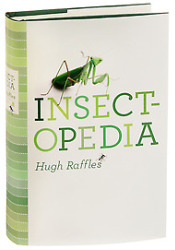 Slutligen verkar Insectopedia, som New York Times recenserar, intressant, om småkryp från A till Z, bl.a. om högtflygande spindlar:
Slutligen verkar Insectopedia, som New York Times recenserar, intressant, om småkryp från A till Z, bl.a. om högtflygande spindlar:In 1926, P. A. Glick, a scientist from the federal Division of Cotton Insect Investigations, and colleagues from the Department of Agriculture, among others, counted about 25 million to 36 million insects, including a ballooning spider they found flying at 15,000 feet, "probably the highest elevation at which any specimen has ever been taken." (A Boeing transatlantic passenger jet flies at an average of 35,000 to 40,000 feet.) We know how the Boeing gets up there, but the spider's launch is an aeronautical feat unequaled by aerospace engineers.
 Drive-By Truckers nya album, The Big To-Do (Spotify), har "lifehacking" som tema, och varje låtar handlar om olika sätt att hantera att göra-listor, för- och nackdelar med GTD och hur man uppnår Inbox Zero-nirvana. (Inte alls "ett hopplöst mischmasch av plakatpolitik, corny
berättelser »ur Söderns djup« och fylleeskapader nedtecknade av
storögda mellanstadiepojkar). Höjdpunkten är låten "This Fucking Job".
Drive-By Truckers nya album, The Big To-Do (Spotify), har "lifehacking" som tema, och varje låtar handlar om olika sätt att hantera att göra-listor, för- och nackdelar med GTD och hur man uppnår Inbox Zero-nirvana. (Inte alls "ett hopplöst mischmasch av plakatpolitik, corny
berättelser »ur Söderns djup« och fylleeskapader nedtecknade av
storögda mellanstadiepojkar). Höjdpunkten är låten "This Fucking Job".(Förresten så är Peter och Svantes "Punktinsatser" bra läsning för hur du får styr på vardagen).
The Guardian - "Space law course to tackle final frontier":
For the first time in a UK syllabus, a module on law and the legal system beyond Earth's atmosphere will be included as an option for students starting at Sunderland University in September. (...)New York Times - "Fending Off Digital Decay, Bit by Bit":
Topics already arising in the field include gaps in health and safety for potential space tourists, and damage to satellites from other objects orbiting the Earth. Looking further ahead, some lawyers have raised questions about land titles on the moon or other planets.
Located in Silicon Valley, Stanford has received a lot of born-digital collections, which has pushed it to become a pioneer in the field. This past summer the library opened a digital forensics laboratory -- the first in the nation.
The heart of the lab is the Forensic Recovery of Evidence Device, nicknamed FRED, which enables archivists to dig out data, bit by bit, from current and antiquated floppies, CDs, DVDs, hard drives, computer tapes and flash memories, while protecting the files from corruption.
Large commercial printing presses - for daily newspapers such as The Sun or the Daily Telegraph - are not used for most of the day while the newspaper is put together.
Mr Davies and his colleagues negotiated a small print run for their paper - called Things Our Friends Have Written On The Internet - and, surprised by the cost, realised others might want to do something similar.
"We've been web people all our lives, and then we accidentally found out through a friend how cheap it was to print," he says.
Uppdatering: 4iP skriver lite om hur Newspaper Club har jobbat:
Next, and this is one of the finest qualities of Newspaper Club, they took their time. They certainly didn't set a go live date and work towards that. They had an idea for a online service but they didn't start building. Instead they talked to lots of the potential customers that had expressed an interest about their idea. Throughout this process the product evolved in subtle but important ways. Only once they were sure they product hypothesis stacked up did they start building.
Next they launched their private beta. The beta wasn't about testing the user need but about execution. Lots of clever people have wonderful ideas for star-ups but an idea is never enough. You need execute brilliantly and arguably this is harder. Step forward VP Eng. Tom Taylor. I won't tell you how reassured I felt when over coffee a few weeks into the beta he told me he'd chucked away all the code and started over. Anyone privy to the private beta can testify that the difference between the product then and now is enormous. The team weren't afraid to say we're wrong and start again.

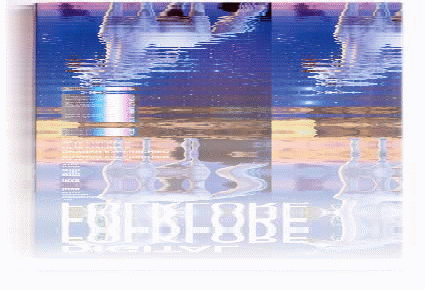
För två och ett halvt år sedan nämnde jag Olia Lialinas utforskande av den folkliga webbdesignen, och nu finns det en hel bok i ämnet digital amatörkultur: Digital Folklore, som we make money not art gillar grymt mycket, och man själv blir sugen att djupdyka i:
Digital Folklore fills a gap in the computer and network culture you'd never know existed if you attend only big tech or web design conferences. Subcultures peopled by lolcats, memes and unsightly fonts are conspicuously absent from these polished gatherings, but that doesn't mean that they are less relevant to computer culture than what you see in the PowerPoint of usability strategists, information designers and other web gurus.
Kognitionsforskare vid "Center for the Ecological Study of Perception and Action", University of Connecticut och "Scientific and Philosophical Studies of Mind Program", Franklin & Marshall College, har empiriskt testat Martin Heideggers idé om zuhanden/"tillhanden" på ett enkelt sätt - genom hur vi reagerar när musen till datorn slutar att fungera.
Genom att studera handrörelserna under olika test konstaterar dom att när musen funkar som den ska så uppvisar rörelserna en frekvens som liknar "skärt brus" (igen!), allt bara flyter på, vi är ett med musen, vi "ser igenom" verktyget. Men så fort den slutar funka så tappar vi vårt synkade bruk av verktyget, och blir medvetna om det, eller som sammanfattningen formulerar det:
In experiment 1, we found that a smoothly coping cognitive system exhibitstype positively correlated noise and that its correlated character is reduced when the system is perturbed. This indicates that the participant and tool constitute a self-assembled, extended device during smooth coping and this device is disrupted by the perturbation. In experiment 2, we examine the re-organization of awareness that occurs when a smoothly coping, self-assembled, extended cognitive system is perturbed. We found that the disruption is accompanied by a change in attention which interferes with participants' performance on a simultaneous cognitive task.
Jag har inte läst artikeln i fråga, men däremot en recension av den engelska utgåvan av Emmanuel Fayes bok Heidegger, l'introduction du nazisme dans la philosophie, om den till synes eviga frågan om Heideggers nazism.
(via: Wired Science)
Vila i frid.
- 2012 firas att det är 100 år sedan Alan Turing föddes - The Alan Turing Year, hence. Man följer upptakten rätt bra på @AlanTuringYear.
- Varje år delar Association for Computing Machinery (ACM) ut Alan M. Turing Award (ej att förväxla med Loebner-priset, för bästa Turing-maskin). I år delades det ut till Chuck Thacker, som på Xerox Palo Alto Research Center bl.a. byggde den första persondatorn med grafiskt användargränssnitt och "skrivbords"-metafor, The Alto.
- David Lagercrantz bok om Alan Turing, Syndafall i Wilmslow, finns numera att köpa i pocket.
Reaction times exhibit a spectral patterning known as 1/f, and these patterns can be thought of as reflecting time-varying changes in attention.We investigated the shot structure of Hollywood films to determine if these same patterns are found.We parsed 150 films with release dates from 1935 to 2005 into their sequences of shots and then analyzed the pattern of shot lengths in each film. Autoregressive and power analyses showed that, across that span of 70 years, shots became increasingly more correlated in length with their neighbors and created power spectra approaching 1/f. We suggest, as have others, that 1/f patterns reflect world structure and mental process. Moreover, a 1/f temporal shot structure may help harness observers' attention to the narrative of a film.New York Times sammanfattar utmärkt forskningen som visar att Hollywood-filmer alltmer pulserar i "skärt brus", bl.a. genom att scener som är lika långa klustras tillsammans (många korta scener tillsammans först, sedan flera långa scener på det) och skapar ett fraktalt mönster som tydligen synkar bra med hur vi tänker:
This mounting synchrony between movie pace and the bouncing ball of the mind's inner eye may help explain why today's films manage to seize and shackle audience attention so ruthlessly and can seem more lifelike and immediate than films of the past...Kolla också den tillhörande grafen, där man ser att Back to the Future uppvisar perfekt skärt brus, medan Walk the Line från senare år, rätt mycket suger.
* James E. Cutting et al, "Attention and the Evolution of Hollywood Film", Psychological Science, doi:10.1177/0956797610361679
 Bloggen Book Patrol beskriver det så här:
Bloggen Book Patrol beskriver det så här:The result is a communal space without fixed function. A softly curvy, feminine expanse without hierarchies or straight lines. A series of calm and silent connected spaces created to nurture collaboration, communication, and cooperation over competition. Library, offices, restaurants, and auditoriums are harmoniously linked between a cloud-like canopy above, and a floor that gently rises and falls like a living organism as it inhales and exhales. "Human movements are not linear like in a train, but curve in a more organic way," said architect Ryue Nishizawa, one-half of team SANAA, explaining his vision. "With straight lines we only create crossroads, but with curves we can create more diverse interactions."
 FF Mister K är ett typsnitt ($142) skapat av finska typformgivaren Julia Sysmäläinen, inspirerad av Franz Kafkas handstil (ovan ett exempel från manuskriptet för Processen, hittat hos kafka.org). I den fina manualen (PDF) till typsnittet beskriver man de olika varianterna som finns:
FF Mister K är ett typsnitt ($142) skapat av finska typformgivaren Julia Sysmäläinen, inspirerad av Franz Kafkas handstil (ovan ett exempel från manuskriptet för Processen, hittat hos kafka.org). I den fina manualen (PDF) till typsnittet beskriver man de olika varianterna som finns:The Regular is a relaxed 'everyday' writing style - Mister K writing down something for himself or to a good friend. The glyphs are fluently con- nected and have lots of form variations without added decorative elements.
The Onstage is Mister K's writing style for less private purposes - special events and persons: Generally more calligraphic, the glyphs have elaborate details especially in the capitals and swashes at the word endings.
The Crossout, finally, shows Mister K's writing when fully dissatisfied with his work - all the words of the text are meticulously crossed out. For especially curious readers texts in 'Crossout' are still readable.
Jag gillar i synnerhet den där sista, överstrukna, varianten:
 Någon borde ge ut Kafkas samlade verk, satta med den här typen, och sedan kan Google scanna in volymerna.
Någon borde ge ut Kafkas samlade verk, satta med den här typen, och sedan kan Google scanna in volymerna. Det finns nu också en uppsättning 600 piktogram i samma stil (FF Mister K Dingbats), där man bl.a. kan föreställa sig vad som hade hänt om Kafka om kafka ägt en "smartphone":
 Inga spår efter skalbaggar bland glyferna.
Inga spår efter skalbaggar bland glyferna. - Reason samlar lite om samtida sociala kontrollmekanismer, med fokus på Storbritannien, och den senaste trenden - "Weaponizing Mozart":
In January it was revealed that West Park School, in Derby in the midlands of England, was "subjecting" (its words) badly behaved children to Mozart and others. In "special detentions," the children are forced to endure two hours of classical music both as a relaxant (the headmaster claims it calms them down) and as a deterrent against future bad behavior (apparently the number of disruptive pupils has fallen by 60 per cent since the detentions were introduced.)
- SvD om ett nytt T-banebibliotek som öppnar i Bredäng idag:
Riktade ljudduschar ska garantera tystnad för övriga besökare.
- Serial Consign om Toronto Sound Ecology:
- trace their route with a polyline
- note the time their walk started and finished
- note the recording device used
- note the weather and temperature
- tag their walk to identify some of the key sounds that occur
- make basic comments about the walk
The site allows our small team of explorers to upload short (5-20 min) soundwalks and then enter the following information:
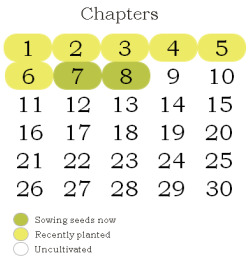 Jag nämnde digress.it tidigare, ett sätt att använda WordPress för att : en trevlig implementering av det är New York Public Librarys "Candide 2.0", där man lagt ut hela texten till Voltaires verk och låtit ett antal "trädgårdsmästare" (i enlighet med avslutningsordens "Låt oss odla vår trädgård") kommentera texten och bjuda in andra till att göra det samma. Dom beskriver det så här:
Jag nämnde digress.it tidigare, ett sätt att använda WordPress för att : en trevlig implementering av det är New York Public Librarys "Candide 2.0", där man lagt ut hela texten till Voltaires verk och låtit ett antal "trädgårdsmästare" (i enlighet med avslutningsordens "Låt oss odla vår trädgård") kommentera texten och bjuda in andra till att göra det samma. Dom beskriver det så här:Candide 2.0 is an experiment in the forms of commentary that Voltaire's readers have always been compelled to make on the book. What do we learn about how readers interact with texts and experiment with ways to leave their mark on what they've read? Such questions can be addressed in the margins themselves as a way to communicate with other readers in this public forum.
| www.flickr.com |
Jag heter Erik Stattin och det här är min blogg. Jag skriver om digital kultur, ungefär. Du får gärna tipsa mig om saker. Kontakta mig på erik.stattin@gmail.com. Jag är mymarkup på Twitter och Delicious.
